Color tattooing is a popular and diverse branch of tattoo art. It encompasses a wide range of styles, such as old-school, color realism, watercolor, new school, neo traditional, and many others.
The key feature of color tattooing is the use of various pigments to create the desired design. Creating a color tattoo requires more time and skill than black and gray tattoos, as multiple pigments are used and a high level of clarity and professionalism is necessary. The use of color in tattooing opens up new possibilities for creative expression and allows for the creation of vibrant, saturated images or photorealistic portraits.
However, it is important to keep in mind that maintaining the clarity and brightness of color tattoos requires more care and attention than black and gray tattoos. Avoiding direct sunlight and tanning the tattooed area, even after healing, is crucial to preserve the colors. Additionally, regular touch-ups every 5 years are recommended to keep the tattoo looking vibrant and the colors saturated.
- Bright, unusual and lively pattern
- Wide choice of styles
- Ability to implement interesting and unusual ideas, a large space for creativity
- Beautiful to look at, especially with small, well-drawn colored details in a large area.
- Higher requirements for the professionalism of the master
- Longer application process
- Fades more and requires more frequent touch-ups
- Some pigments cannot be removed by laser
- Possible allergies to some color pigments.
So, about the main element of creating a colored tattoo – the tattoo colors – we will discuss in detail in the article.
Different Types of Tattoo Ink
When it comes to tattoo ink, there are three main types: pigment-based inks, dye-based inks, and natural inks.
-
Pigment-based inks are the most commonly used type of tattoo ink. They are made from a combination of pigments, which are insoluble color particles suspended in a carrier solution. Pigment-based inks come in a wide variety of colors and are known for their durability and resistance to fading. Some popular brands of pigment-based inks include Eternal Ink, Starbrite Colors, and Intenze.
-
Dye-based inks, on the other hand, are made from a combination of dyes, which are soluble color particles that are absorbed by the skin. Dye-based inks are generally considered to be less durable than pigment-based inks, and tend to fade over time. However, they are known for their ability to produce bright and vibrant colors. For dye-based inks, some popular brands include Kuro Sumi, Dynamic Color, and Radiant Colors.
-
Finally, natural inks are made from a variety of natural ingredients, such as fruits, vegetables, and minerals. These inks are often used in traditional or ceremonial tattoos, and are known for their rich, earthy colors. However, they are not as widely used as pigment-based and dye-based inks, and may be harder to find. Natural inks can be harder to find than the other types of inks, but some popular brands include Jagua, Hush, and Skin Candy. It’s worth noting that the tattoo industry is not regulated, so not all brands are created equal. It is always advisable to do research and check for the reputable brands, read reviews, and ask for recommendations from experienced tattoo artists before choosing a brand of ink.
It is important to note that the quality of the ink also plays a huge role in the final outcome of the tattoo. It is always advisable to check the quality of the ink and the brand before getting a tattoo done. Also, it is important to consult with your tattoo artist, who can recommend the best type of ink for your individual needs and preferences.
Popular Tattoo Colors
-
Black
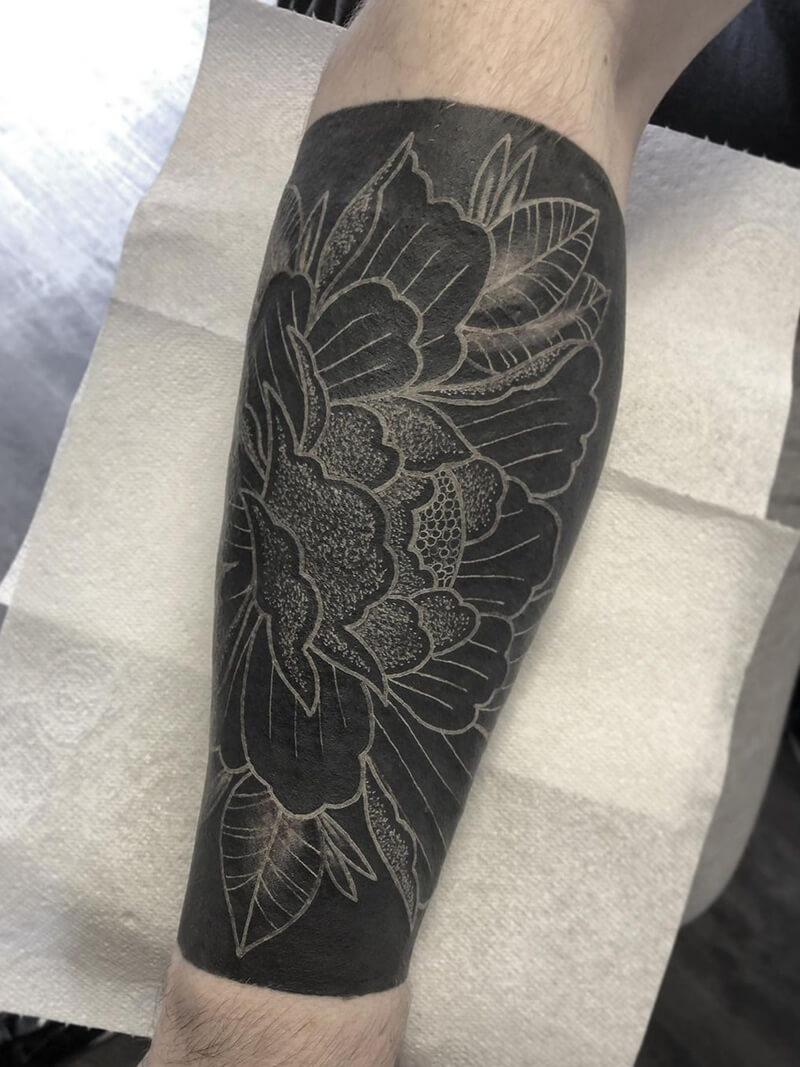
Black is perhaps the most popular color for tattoos and is known for its rich, dark and bold appearance. It is a classic color that is associated with strength, power, and mystery. Black tattoos are versatile and can be used in a variety of designs and styles, from traditional to contemporary. Black ink is opaque and creates a strong, striking effect in the tattoo design. It is the most stable and has the lowest fading rates over time and under the influence of external factors. In addition to being used in black and white tattoos, black is also present in the outlines of drawings (e.g., typical of old school style) and other elements of colored tattoos. Choosing a quality pigment from a good manufacturer, you are more likely to get a rich and dense black in the finished and healed tattoo.
-
Red
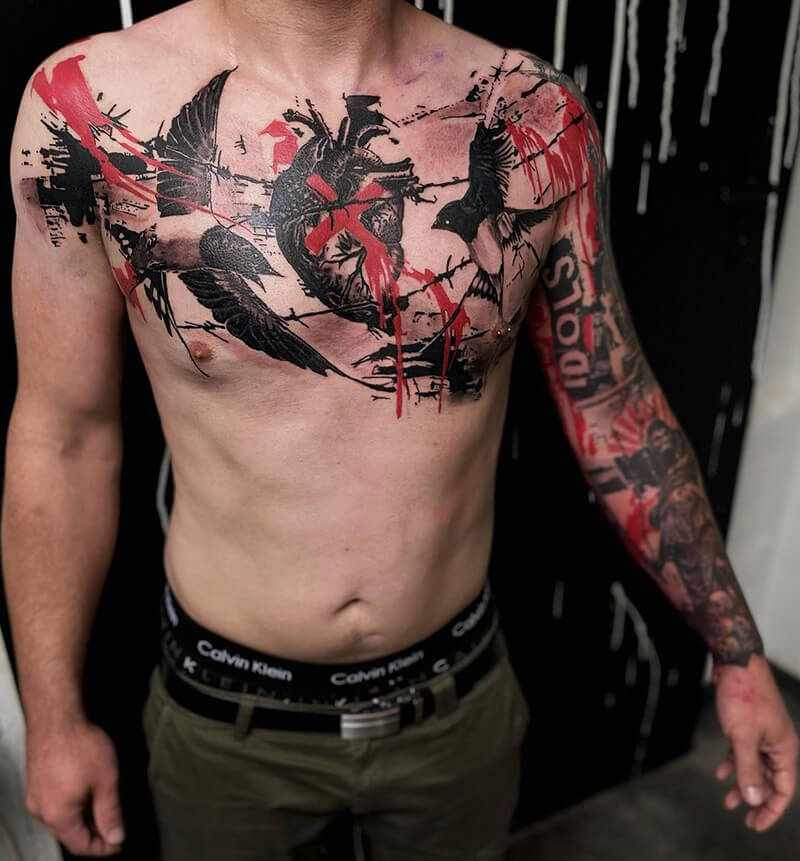
Red is a bold and vibrant color that is associated with passion, energy, and love. Red ink can create a striking and eye-catching effect in the tattoo design, and it is often used in combination with other colors. Red tattoos can be used to create a variety of designs, from hearts and flowers to flames and tribal patterns. Also red is one of the two main colors in the style of tattoo trash polka, where it looks more aggressive and tough. The purely red tattoos are also very popular, they look delicate and aesthetically pleasing. Red is also less susceptible to fading, so feel free to choose this color for your designs. The following elements are added as coloring elements in red tattoo paints: cinnabar, red cadmium (cadmium selenide), iron oxide (rust), mercury sulfide, naphthol.
-
Green
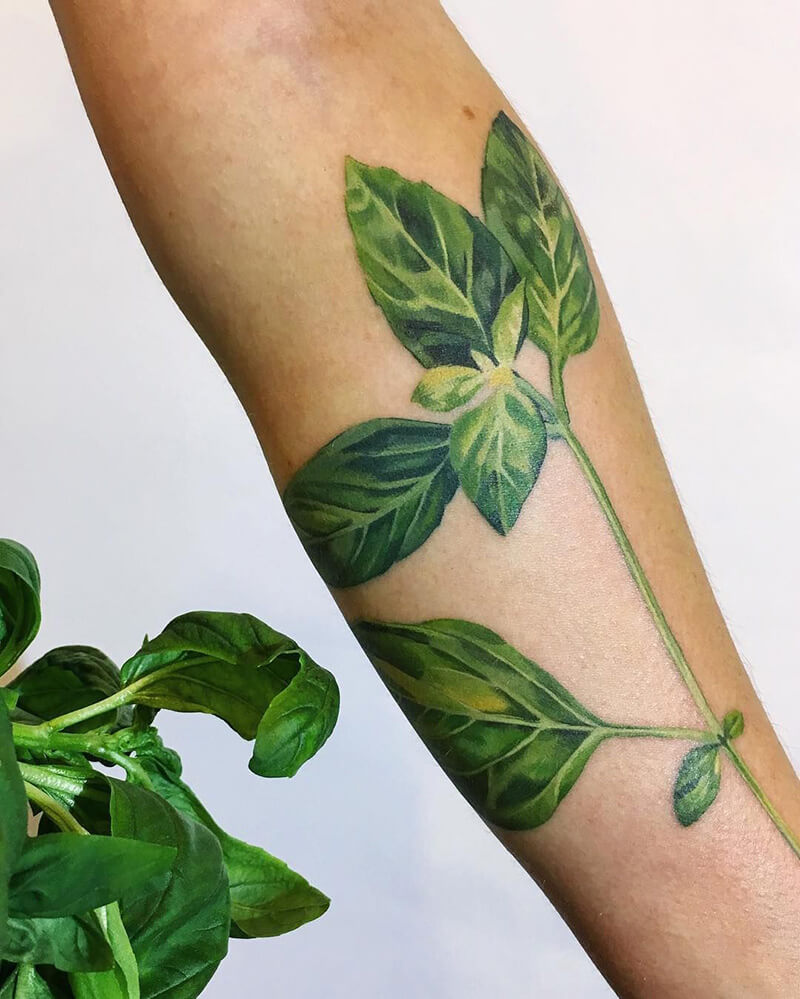
Green is a refreshing and rejuvenating color that is associated with nature, growth, and life. Green ink creates a fresh and natural effect in the tattoo design and it is often used in combination with other colors. Green tattoos can be used to create a variety of designs, from leaves, trees, and flowers to geometric patterns and abstract designs. The fading and appearance of color on the skin is very much influenced by individual skin indicators: for some, the green color stays in the skin unchanged for years, while for others, it fades over time, so they need to make a correction.
The following elements can be used as pigments for these paints: chromium oxide (Casalis Green or Anadomis Green), lead chromate, malachite. Often green tattoo paint contains impurities – potassium ferricyanide (yellow or red) and iron ferricyanide (Prussian blue).
-
Blue
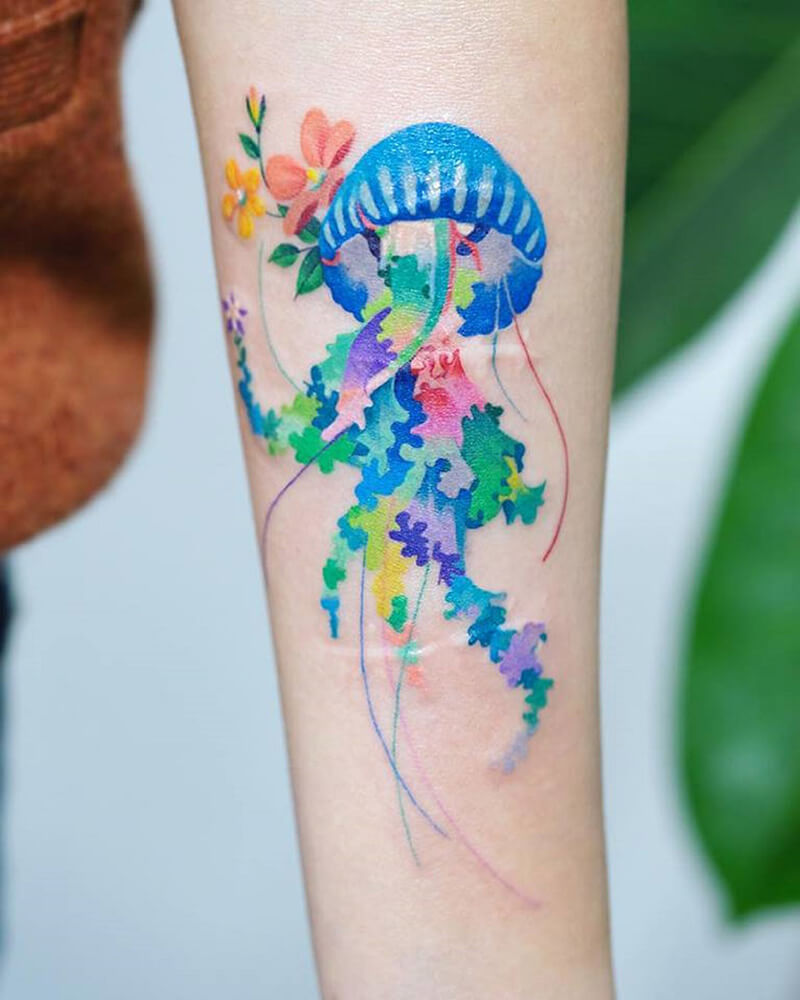
Blue is a calming and soothing color that is associated with serenity, trust, and loyalty. Blue ink creates a soothing and peaceful effect in the tattoo design, and it is often used in combination with other colors. Blue tattoos can be used to create a variety of designs, like waves and ocean scenes. If you use delicate pastel shades of blue, most likely over time, you will need to make regular corrections to your tattoo, as such shades tend to fade due to their unsaturated nature.
-
Yellow
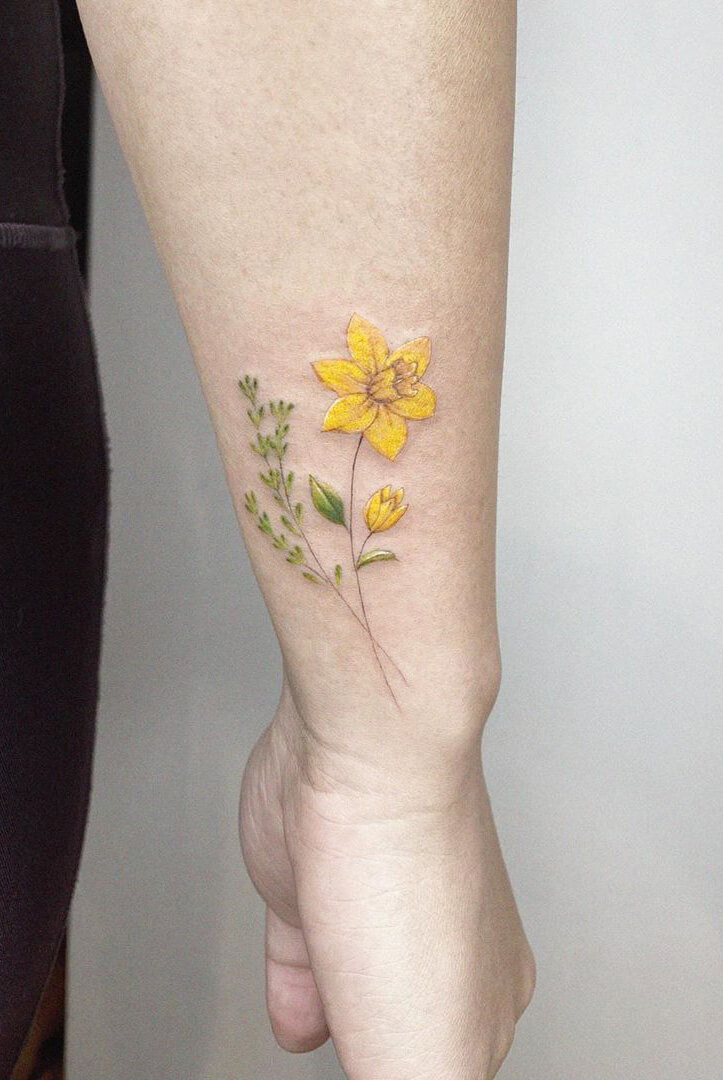
When it comes to yellow tattoo inks, there are a few things to consider. Yellow is a transparent color, meaning that it allows the underlying skin tone to show through. This can make yellow tattoos appear more subdued and natural on some skin tones, while on other skin tones it can appear more vibrant. This is something to take into account when choosing the yellow ink for your tattoo. Yellow tattoo inks are considered to be less durable than other colors, and are more prone to fading over time, especially when exposed to the sun. Therefore, it is important to choose high-quality inks and to take proper care of your tattoo to ensure that the colors remain vibrant for as long as possible. It’s also important to consult with your tattoo artist, who can help you choose the best shade of yellow ink for your skin tone and tattoo placement.
Yellow is a warm and vibrant color that is associated with happiness, optimism, and warmth. Yellow tattoos can be used to create a variety of designs, from flowers and suns to geometric patterns and abstract designs.
As the coloring elements in the yellow tattoos in the composition can be used such elements: cadmium sulfide, chromium oxide and turmeric (curcumin), a plant from the ginger family.
-
White
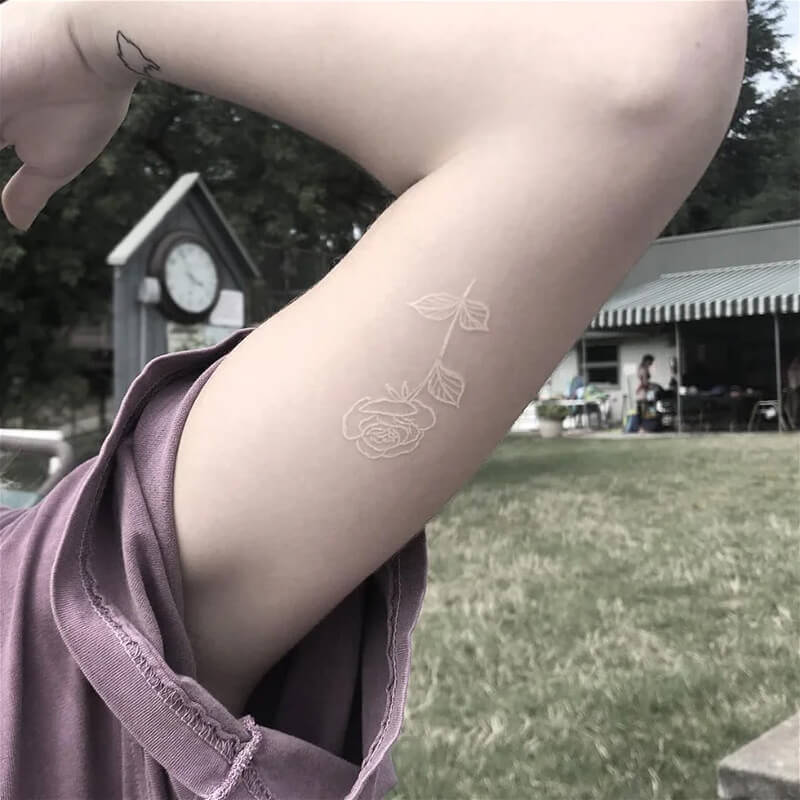
White tattoo inks are also very popular, as they are often used to create shades of primary colors. Also, white ink is often used as a highlight color, to add contrast and brightness to a tattoo design, especially when used in combination with darker colors. As coloring elements in white tattoo paints can be used such elements as white lead (lead carbonate), titanium dioxide, zinc oxide, barium sulfate. Minerals such as anatase and rutile are also used.
White is a clean, crisp and luminous color that is associated with purity, innocence and simplicity. White tattoos can be used to create a variety of designs, from small highlights, to lettering, and even full-color tattoos.
So, What are the Best Colors for Tattoos?
The best colors for tattoos depend on personal preference and the desired final appearance of the tattoo. But in the context of the best colors to use for tattoos, it is still worth noting a few key points. Dark colors with a high level of saturation feel best in the skin: blue, red, brown, purple. Pale and pastel shades lose their saturation most quickly: delicate pink, blue, light yellow and so on, in which the same watercolor tattoos, which are carried out without using dense procreation, with a high degree of dilution of paint to preserve the airiness of the tattoo, are most often performed.
Also compared to black and white, colored tattoos are more subject to fading. Ink quality and other variables greatly affect how quickly they can fade, but the general rule of thumb is that black and white tattoos are more durable.
Mixing Inks and Colors
You have two options to get started with the right shade of paint. The first is to buy the right color in the store, the second is to mix it yourself from the pigments you have already purchased. There is a nuance. If you remember from childhood that by mixing yellow and blue – you get a green, and adding white makes any paint lighter and brighter, then in the case of the paint for tattoos the case is somewhat different.
Since many of the pigments contain oxides of different metals, and carriers can be different in composition, in which case come into play not only artistic laws, but also chemical. In short, mixing paints sometimes leads to unpredictable results, not always what you expect. Therefore, if you all the same got the necessary shade – mix up at once so much paint that for sure was enough for that tattoo on which you work now.
Factors that Affect Tattoo Color
-
Skin tone
Different skin tones can absorb and reflect colors differently, which can affect the final outcome of your tattoo. For example, lighter skin tones tend to reflect more light, which can make colors appear more vibrant. On the other hand, darker skin tones tend to absorb more light, which can make colors appear more subdued. Your tattoo artist can help you choose colors that will complement your skin tone and create a natural-looking tattoo.
-
Age of tattoo
Another important factor that can affect tattoo color is the age of the tattoo. As tattoos age, the ink can fade and change color over time. Factors such as sun exposure, improper aftercare, and the quality of the ink can all contribute to the fading of tattoo colors.
-
Placement on the body
Different areas of the body can absorb and reflect colors differently, which can affect the final outcome of your tattoo. For example, tattoos on areas of the body that are exposed to the sun, such as the arms and legs, are more likely to fade over time. On the other hand, tattoos on areas of the body that are covered by clothing, such as the chest or back, are less likely to fade.
-
Sun Exposure
UV rays can cause the ink to fade, blur or change color over time, and that’s why it is important to take proper care of your tattoo and protect it from the sun. Sunscreen is a must for all tattoos, especially for the ones that are in exposed areas, and should be applied every time you go outside. Also, it’s recommended to cover up your tattoos with clothing or bandages when spending time in the sun for extended periods of time. If you notice that your tattoo has changed color or faded after sun exposure, it’s a good idea to consult your tattoo artist to see if there is anything that can be done to restore the tattoo to its original color.
-
Color Tattoos vs Black and Gray Tattoos
Color tattoos are more likely to fade over time than black and gray tattoos. This is because black and gray tattoos use a single color of ink, which is less likely to fade over time. However, color tattoos can be more vibrant and eye-catching than black and gray tattoos.
Tattoo Colors for Different Skin Tones
Different skin tones can absorb and reflect colors differently, which can affect the final outcome of a tattoo. When choosing tattoo colors, it’s important to consider the undertone of your skin and how it will affect the final appearance of the tattoo.
For those with light skin tones, lighter colors such as pale pink, yellow, and white tend to show up well and can create a bright and vibrant effect. However, darker colors such as black and dark blue may appear more subdued and may need to be applied more heavily to show up as intended.
For those with medium skin tones, a wider range of colors can work well. Bright and bold colors such as reds, greens, and blues tend to show up well, as well as more neutral shades like gray and black.
For those with dark skin tones, darker colors such as black and dark blue tend to show up well, as well as bright and bold colors like reds, purples, and greens. Lighter colors such as pale pink and yellow may appear more subdued and may need to be applied more heavily.
It’s worth noting that when it comes to tattooing, there is no one-size-fits-all approach and the final outcome of a tattoo may vary depending on the individual’s skin tone, the ink used and the tattoo artist’s skill.
FAQ
Are Color Tattoos More Expensive?
Color tattoos can be more expensive than black and gray tattoos. The cost of a tattoo can vary depending on several factors, including the size, placement, and complexity of the design, as well as the skill and experience of the tattoo artist.
Color tattoos often require more time and skill to create, as the tattoo artist needs to mix and match different colors to create the desired effect. This can add to the overall cost of the tattoo. Additionally, color tattoos may require more touch-ups and maintenance over time, which can also add to the cost.
However, it's worth noting that the cost of a tattoo can vary greatly depending on the location, the tattoo artist, and the shop. Some tattoo shops may charge more for color tattoos, while others may charge the same price for both color and black and gray tattoos. It's always a good idea to shop around and get quotes from different tattoo artists and shops before making a decision.
Color Tattoos vs Black and Gray Tattoos?
Color tattoos and black and gray tattoos are two popular styles of tattooing, each with its own unique characteristics and benefits.
Color tattoos are known for their vibrant and eye-catching appearance, and they can be used to create a wide range of designs, from realistic portraits to abstract and artistic creations. The use of multiple colors allows for a greater degree of artistic expression, and they can be used to create a range of moods, emotions, and effects. However, color tattoos require more skill and time to create than black and gray tattoos, and are more prone to fading over time, especially when exposed to the sun.
Black and gray tattoos, on the other hand, are known for their timeless, classic look, and for their ability to create fine details, shading, and texture. Black and gray tattoos are popular for creating realistic images, such as portraits, and for creating a more understated and subtle effect. They are also more durable and less prone to fading over time.
Ultimately, the choice between a color tattoo and a black and gray tattoo depends on personal preference, the desired final appearance, and the symbolism and meaning behind the tattoo. It's important to consult with your tattoo artist, who can help you choose the best style for your individual needs and preferences.
Conclusion
Tattoo colors manufacturers have reached a new level of quality, reducing the risks associated with rejection by the body and allergic reactions. However, colored tattoos are still very fragile decorations and require proper care in order to maintain their appearance. Additionally, choosing an experienced tattoo artist who uses high-quality ink is essential for guaranteeing successful results.

